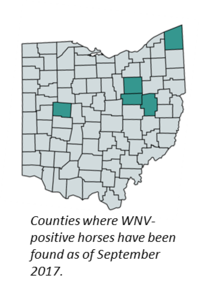Ohio ADDL Assists CDC and FDA in Campylobacter Outbreak
Melanie Prarat, MS, ADDL Virology Section
As a member of FDA's Veterinary Laboratory Investigation and
Response Network (Vet-LIRN), the ADDL provides laboratory
capacity for outbreak investigations to test
for zoonotic pathogens.
In September, the Ohio Department of Health (ODH) and the Center for Disease Control and Prevention (CDC) requested the ADDL to assist in the investigation of a multistate outbreak of human Campylobacter infections
linked to puppies sold through a national pet store chain. To date, 39 human cases have been identified in 7 states, including 18 people from Ohio. Pet food
and fecal samples from several Ohio pet
stores have been submitted by investigators to ADDL for culture and PCR testing. Whole genome sequencing of Campylobacter isolates
is being performed by the ADDL and shared with the affiliated federal and state agencies for
epidemiology studies.
Campylobacteriosis is
an infectious disease caused by bacteria of the genus Campylobacter.
Animals
including dogs infected with bacteria may or may not show clinical signs.
This investigation is ongoing. Updates will be provided as more information becomes available.
 EHD Update
Dr. Jeff Hayes, MS, DVM, ADDL Pathology Section
As of September 27, 2017,
the number of counties with white-tailed deer diagnosed with epizootic hemorrhagic disease (EHD) virus infection has expanded from three to 11 and the number of counties with infected cattle has increased from 2 to 4
since last month. Eleven individual wild deer and captive deer from 2 farms have been
diagnosed from Belmont, Columbiana, Cuyahoga, Gallia, Highland, Holmes,
Jefferson, Lorain, Pickaway, Pike, and Ross counties. Confirmed infected
cattle have been from Carrol, Columbiana, Highland and Jefferson
counties.
As clinical signs of EHD infection in cattle (reviewed in the September
ADDL newsletter) may mimic those of reportable diseases such as foot and mouth
disease, vesicular stomatitis and bluetongue, veterinary practitioners
are reminded that they are to report such cases in cattle to the State
Veterinarian (614-728-6220) or the USDA APHIS Area Director (614-856-4735).
People are encouraged to report sightings of sick and dead deer to their local
Division of Wildlife office.
|
 Seven Horses Confirmed with WNV Infections in Ohio
Dr. Jeff Hayes, MS, DVM, ADDL Pathology Section
Ohio
now has seven horses confirmed with West Nile virus (WNV) infections in 2017 as
determined by serologic testing at the National Veterinary Services
Laboratories in Ames, Iowa. None of the seven affected horses had been
vaccinated against WNV. Two horses died spontaneously, one had to be
euthanized due to poor prognosis, and four horses have recovered from illness,
although two have sequela such as neurologic deficits. The horses have been
from five counties - Ashtabula, Holmes, Logan (2 horses), Tuscarwaras, and Wayne (2
horses). Six horses have been Standardbreds aged 4 to 12 years old and one was a 6 year old Belgian mare.
Onset
of clinical signs was observed in these horses between August 24 and September
5. Clinical signs reported
among the affected horses included weakness of front or rear or all four limbs,
incoordination, wobbling of the head, hypersensitivity to sound, sight and touch,
muscle fasciculations, lethargy, inability or refusal to eat or drink, variable
fever up to 103 F and recumbency with inability to rise.
State Veterinarian Dr. Tony Forshey said these cases should serve as a
reminder to get animals vaccinated and that vaccines are a proven prevention
tool against viruses like WNV and EEE. In addition to vaccinations, horse
owners also should work to reduce the mosquito population and eliminate
possible breeding areas. Recommendations include: removing stagnant water sources;
keeping animals inside during the bugs' feeding times, which are typically
early in the morning and evening; and using mosquito repellents.
Back to top
|
Upcoming CWD Training
October 31 is the date of
the next annual Chronic Wasting Disease (CWD) training session for veterinarians who want to participate in
the captive white-tailed deer herd certification program. The training will include
presentations on herd inventory and testing requirements, inspections, a review
of key cervid diseases and training on chronic wasting disease sample
collection. The training will be from 9 am to 3 pm. Included in the afternoon is a wet lab where class members have
hands on training in sample collection of obex and retropharyngeal lymph node
samples. Training is free and includes notes and a notebook. Lunch is on
your own. If you are interested in attending this year’s training, contact
Christi Clevenger at 614-728-6220.
Back to top
USDA/NIFA Offers Veterinary Medical Loan Repayment Program
Anne Parkinson, ADDL Serology Section
The
USDA’s National Institute of Food and Agriculture (NIFA) has announced a program
aimed at assisting veterinarians in repaying loans associated with the pursuit
of their veterinary medicine degrees.
This program, the Veterinary Medical Loan Repayment Program (VMLRP), is
authorized by the National Veterinary Medical Services Act and helps qualified
veterinarians offset a significant amount of their school loans in return for
their service in identified high-priority veterinary shortage situations. If a veterinarian elects to enter a loan
repayment agreement with NIFA, they will agree to provide veterinary services
in an area experiencing a shortage of veterinarians for a determined amount of
time. NIFA can repay up to $25,000 of
student debt per year when a veterinarian commits to at least three years of
service in a designated shortage area.
To learn more about this program and how to apply, please refer to the VMLRP
page on the NIFA website for additional information.
Back to top
Lab Closed on Monday,
October 9
The Ohio ADDL will be closed on Monday, October 9, 2017 in observance of Columbus Day.
For additional information and resources, please visit our website. If you need to contact us regarding an urgent matter, please use our after hours phone number: (888) 456-3405.
|